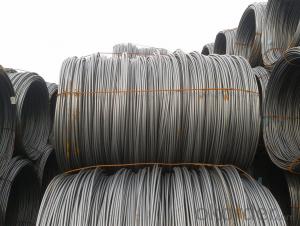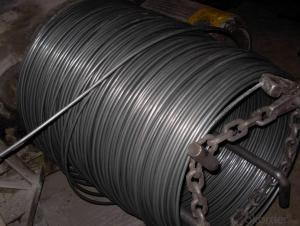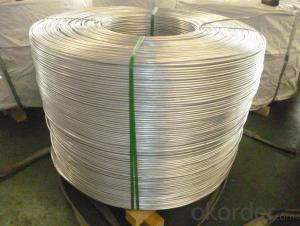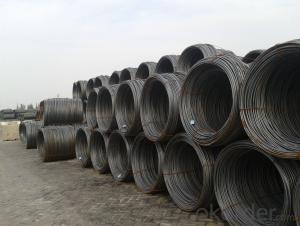SAE1006Cr Carbon Steel Wire Rod 14mm for Welding
- Loading Port:
- Shanghai
- Payment Terms:
- TT OR LC
- Min Order Qty:
- 100 m.t
- Supply Capability:
- 30000 m.t/month
OKorder Service Pledge
OKorder Financial Service
You Might Also Like
Item specifice
Description of SAE1006Cr Carbon Steel Wire Rod 14mm for Welding:
OKorder is offering Color Coated Steel Coil Prepainted Steel Coil at great prices with worldwide shipping. Our supplier is a world-class manufacturer of steel, with our products utilized the world over. OKorder annually supplies products to European, North American and Asian markets. We provide quotations within 24 hours of receiving an inquiry and guarantee competitive prices.
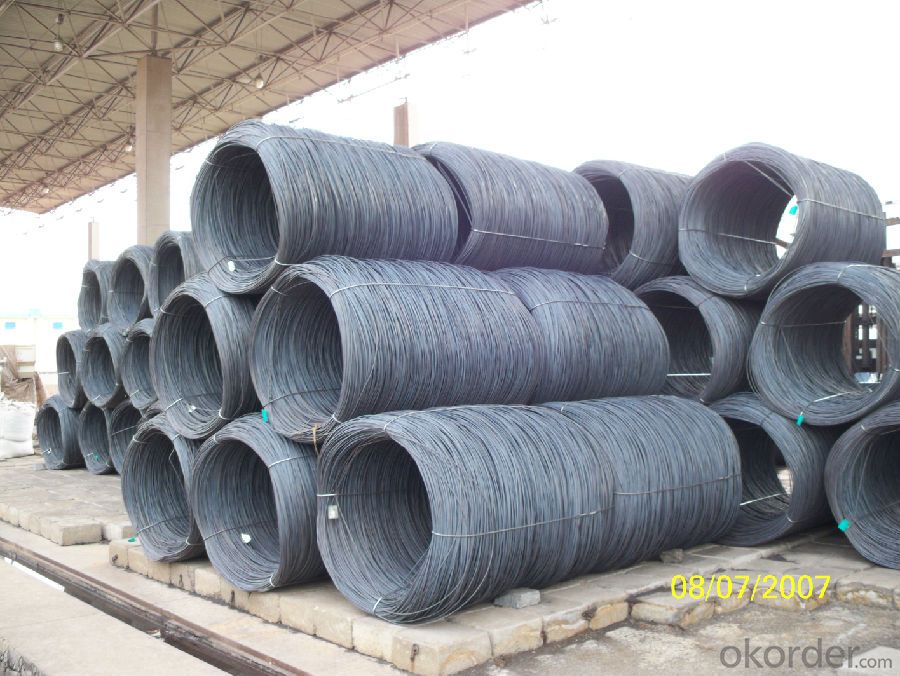
Applications of SAE1006Cr Carbon Steel Wire Rod 14mm for Welding:
Color Coated Steel Coil Prepainted Steel Coil are ideal for structural applications and are widely used in the construction of buildings and bridges, and the manufacturing, petrochemical, and transportation industries.
Main Product Features of SAE1006Cr Carbon Steel Wire Rod 14mm for Welding:
· Premium quality
· Prompt delivery & seaworthy packing (30 days after receiving deposit)
· Corrosion resistance
· Can be recycled and reused
· Mill test certification
· Professional Service
· Competitive pricing
Specifications of SAE1006Cr Carbon Steel Wire Rod 14mm for Welding:
1, Introduction: Color coated steel coils(sheets), i. E. PPGI, also called prepainted steel coils(sheets), are made of galvanized steel coils(sheets) with polymer coatings as surface. It's a new enclosure material and building board with characteristics of light-weighted, heat preserved&insulated, easily installed with bright colors.
2, Production Process: Pretreatment(Degreasing)_Drying_Chromating_Paint Basic Oil_Cooling_Drying_Color Coating_Cooling_Film-covering_Rolling Up
3, Characteristics:
Good at corrosion resistence. Besides zinc coating of the basic plate of galvanized steel sheet, the color coating as the surface has double lifetime to ensure better anticorrosion effect.
With excellent cold bending molded manufacturablity, PPGI products can be processed or directly used as final product. As being light-weighted and conveniently transported, they're widly used to replace wood to save energy.
4.There're thousands of colors can be chosen as per different application. Any color plays well in decoration.
No pollution with high recycling rate, PPGI coils and sheets are strongly recommended as enviroment-friendly products by the government.
5, eye bands and 4 circumferential bands in steel, galvanized metal fluted rings on inner and outer edges, galvanized.
| commodity | SAE1006Cr Carbon Steel Wire Rod 14mm for Welding |
| Techinical Standard: | JIS G3302-1998, EN10142/10137, ASTM A755 |
| grade | Q195,Q215,Q235,SAE1006,SAE1008 SAE1006Cr |
| Types: | Mesh welding |
| Base metal | galvanized, galvalume, cold rolled steel |
| Thickness | 0.14-1.0mm(0.16-0.8mm is the most advantage thickness) |
| Width | 610/724/820/914/1000/1200/1219/1220/1250mm |
| Type of coating: | PE, SMP, PVDF |
| Zinc coating | Z60-150g/m2 or AZ40-100g/m2 |
| Top painting: | 5 mic. Primer + 15 mc. R. M. P. |
| Back painting: | 5-7 mic. EP |
| Color: | According to RAL standard |
| ID coil | 508mm610mm |
| Coil weight: | 2--3MT |
| Package: | Properly packed for ocean freight exportation in 20'containers |
| Application: | Industrial panels, roofing and siding for painting/automobile |
| Price terms | FOB, CFR, CIF |
| Payment terms | 20%TT in advance+80% TT or irrevocable 80%L/C at sight |
| delivery time | 25 days after recepit of 20% TT |
| Remarks | Insurance is all risks |
| MTC 3.1 will be handed on with shipping documents | |
| We accept SGS certificatation test |
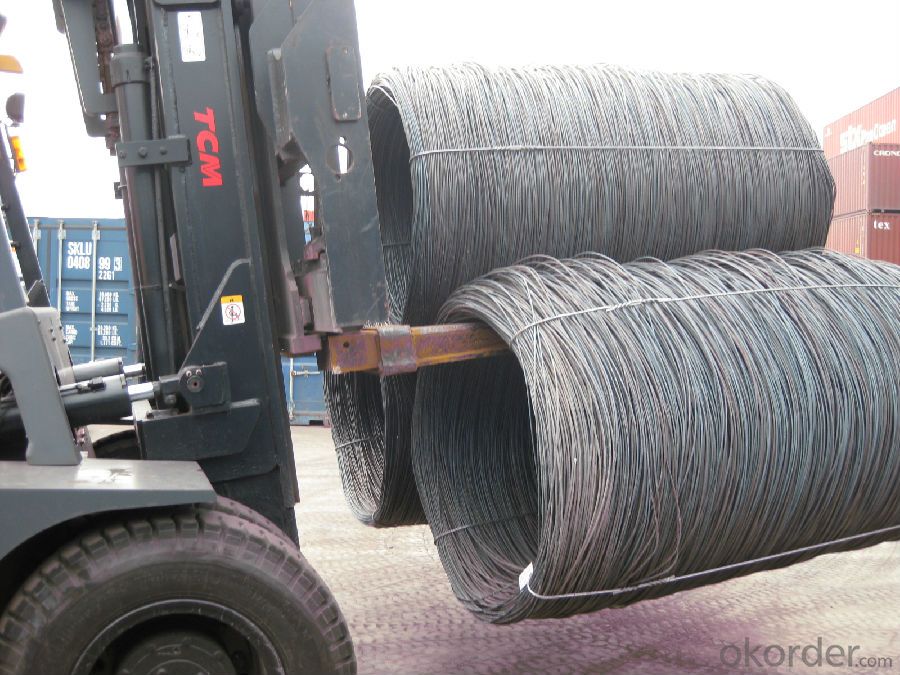
FAQ of SAE1006Cr Carbon Steel Wire Rod 14mm for Welding:
Q1: Why buy Materials & Equipment from OKorder.com?
A1: All products offered byOKorder.com are carefully selected from China's most reliable manufacturing enterprises. Through its ISO certifications, OKorder.com adheres to the highest standards and a commitment to supply chain safety and customer satisfaction.
Q2: How do we guarantee the quality of our products?
A2: We have established an advanced quality management system which conducts strict quality tests at every step, from raw materials to the final product. At the same time, we provide extensive follow-up service assurances as required.
Q3: How soon can we receive the product after purchase?
A3: Within three days of placing an order, we will begin production. The specific shipping date is dependent upon international and government factors, but is typically 7 to 10 workdays.
Q4: What makes stainless steel stainless?
A4: Stainless steel must contain at least 10.5 % chromium. It is this element that reacts with the oxygen in the air to form a complex chrome-oxide surface layer that is invisible but strong enough to prevent further oxygen from "staining" (rusting) the surface. Higher levels of chromium and the addition of other alloying elements such as nickel and molybdenum enhance this surface layer and improve the corrosion resistance of the stainless material.
Q5: Can stainless steel rust?
A5: Stainless does not "rust" as you think of regular steel rusting with a red oxide on the surface that flakes off. If you see red rust it is probably due to some iron particles that have contaminated the surface of the stainless steel and it is these iron particles that are rusting. Look at the source of the rusting and see if you can remove it from the surface.
- Q:What are the common packaging materials used for steel wire rod coils?
- The common packaging materials used for steel wire rod coils are wooden pallets, steel straps, and plastic wrapping.
- Q:What are the main factors affecting the weldability of steel wire rod?
- The main factors affecting the weldability of steel wire rod include the composition and properties of the steel, including its carbon content and alloying elements, as well as the presence of impurities or surface contaminants. The size and shape of the wire rod, including its diameter and surface condition, can also impact weldability. Additionally, the welding process and parameters, such as heat input and welding speed, as well as the skill and technique of the welder, play a significant role in determining the weldability of steel wire rod.
- Q:What are the different wire drawing processes used for steel wire rod?
- The different wire drawing processes used for steel wire rod include cold drawing, hot drawing, and die drawing. Cold drawing involves pulling the wire rod through a series of dies to reduce its diameter and increase its length. Hot drawing involves heating the wire rod and then using a series of dies to reduce its diameter. Die drawing is a process where the wire rod is pulled through a single die to achieve the desired diameter and length.
- Q:What are the main factors influencing the choice of steel wire rod packaging materials?
- The main factors influencing the choice of steel wire rod packaging materials can vary depending on various factors. However, some of the key factors include: 1. Product characteristics: The characteristics of the steel wire rod, such as its size, shape, weight, and fragility, play a crucial role in determining the appropriate packaging material. For instance, if the wire rod is heavy or has sharp edges, it may require stronger packaging materials like steel crates or wooden pallets to ensure safe transportation. 2. Transportation and handling requirements: The mode of transportation, distance, and handling conditions also influence the choice of packaging materials. If the wire rods are being transported over long distances or via rough terrain, more durable and robust packaging materials may be needed to protect the product from damage or breakage. 3. Environmental factors: Environmental conditions, such as temperature, humidity, and exposure to moisture or corrosive substances, can impact the choice of packaging materials. For instance, if the wire rods are being stored or transported in humid environments, packaging materials that offer moisture resistance, such as plastic or coated materials, may be preferred. 4. Cost-effectiveness: The cost of packaging materials is another important factor to consider. Companies need to evaluate the cost-effectiveness of different packaging options, taking into account factors such as material cost, durability, and potential for reuse or recycling. Balancing cost with the necessary level of protection is essential to ensure profitability. 5. Regulatory compliance: Compliance with industry regulations and standards is crucial in choosing the packaging materials. Certain industries or regions may have specific requirements for packaging materials, such as fire-resistant properties, eco-friendly materials, or certifications like ISO standards. Adhering to these regulations is essential for legal and ethical reasons. 6. Customer expectations: Customer preferences and expectations also play a role in determining the choice of packaging materials. For example, if customers value sustainability and eco-friendly packaging, companies may opt for recyclable or biodegradable materials to align with their customers' values. In conclusion, the choice of steel wire rod packaging materials is influenced by several factors, including product characteristics, transportation requirements, environmental factors, cost-effectiveness, regulatory compliance, and customer expectations. Companies need to carefully evaluate these factors to select the most appropriate packaging materials that ensure the safe transportation and delivery of the wire rods while meeting customer demands and regulatory requirements.
- Q:How is steel wire rod classified based on its surface condition?
- Steel wire rod can be categorized into three main groups based on its surface condition. The first category is bright or untreated surface, which refers to wire rod that has not undergone any surface treatment or coating. This type of wire rod has a clean and smooth surface, without any contaminants or oxidation. It is commonly used in applications that require a clean appearance or high conductivity, such as electrical wire manufacturing, cable production, and spring production. The second category is coated or galvanized surface, which involves treating the wire rod with a protective layer, usually through galvanization or zinc coating. This protective coating enhances the wire rod's resistance to corrosion by acting as a barrier against moisture and other corrosive elements. It makes the wire rod suitable for outdoor applications or environments with high humidity or exposure to chemicals. Industries like construction, fencing, and automotive often use coated steel wire rod. The third category is coated and drawn surface, which refers to wire rod that has undergone both a coating and a drawing process. The coating is applied to the wire rod before it is drawn through a series of dies, reducing its diameter and increasing its tensile strength. This process results in a smooth and uniform surface with improved mechanical properties. Coated and drawn steel wire rod is commonly used in applications that require high-strength wire, such as wire ropes, tire reinforcement, and suspension springs. In conclusion, classifying steel wire rod based on its surface condition aids in determining its suitability for various applications, considering factors like corrosion resistance, conductivity, appearance, and mechanical properties.
- Q:How is the decarburization of steel wire rod evaluated?
- The decarburization of steel wire rod is typically evaluated by conducting various tests such as microscopic examination, hardness testing, and chemical analysis to determine the depth and extent of carbon depletion on the surface of the rod.
- Q:How is a steel wire rod manufactured?
- A steel wire rod is manufactured through a series of steps in a steel mill. The process begins with the melting of iron ore in a blast furnace to remove impurities and create molten iron. The molten iron is then transferred to a basic oxygen furnace (BOF) or an electric arc furnace (EAF) for further refining. In the BOF or EAF, the molten iron is combined with scrap steel and other alloying elements to achieve the desired composition and quality. This mixture is then subjected to high temperatures and chemical reactions, which help remove impurities and adjust the carbon content. Once the desired composition is achieved, the molten steel is cast into billets or blooms through continuous casting. These billets or blooms are solidified into a semi-finished product, which is then reheated to a rolling temperature. The reheated billet or bloom is then passed through a series of rolling mills. In the first stage, it goes through a roughing mill that reduces its size and shape. From there, it enters a series of intermediate and finishing mills, which gradually reduce the cross-sectional area and refine the shape further. During the rolling process, the steel is subjected to high pressure, which elongates it and reduces its diameter. This continuous elongation and reduction in size help improve the strength and ductility of the wire rod. After the final rolling pass, the wire rod is cooled and coiled onto a spool. It is then subjected to various surface treatments, such as pickling or coating, to remove any mill scale or oxidation and improve its surface quality. Finally, the wire rod is tested for its mechanical properties, dimensions, and surface quality. It is then either shipped to customers as a finished product or further processed into various steel wire products, such as wires for construction, automotive, or industrial applications. Overall, the manufacturing of a steel wire rod involves a combination of melting, refining, casting, rolling, and surface treatment processes to produce a high-quality product with the desired properties.
- Q:How are steel wire rods used in the manufacturing of fasteners?
- Fasteners, including bolts, screws, and nails, rely on steel wire rods as a vital component in their production. Steel wire rods serve as the raw material, imparting the strength and durability required for these fasteners. The manufacturing process commences with the utilization of steel wire rods, typically made from carbon or alloy steel. These rods undergo a hot rolling process, where they are heated and passed through a series of rollers to achieve the desired shape and size. The resulting wire rods then undergo further processing to meet the specific requirements for fastener production. One of the primary applications of steel wire rods in fastener manufacturing is for the production of bolts and screws. The wire rods are cut into specific lengths and undergo various operations, such as heading, threading, and heat treatment. Heading involves shaping the head of the bolt or screw, while threading creates the ridges or grooves necessary for proper installation. Heat treatment is often employed to enhance the strength and hardness of the fastener. Steel wire rods are also utilized in the production of nails. The rods are drawn to the desired diameter and cut into appropriate lengths. The ends of the wire are then sharpened, and the nails are formed through a process called pointing. Pointing involves creating a sharp tip on one end of the wire, facilitating easy penetration into materials. In addition to bolts, screws, and nails, steel wire rods find use in the production of other fasteners, such as rivets, cotter pins, and clips. These fasteners are essential across various industries, including construction, automotive, aerospace, and furniture. Overall, the significance of steel wire rods in fastener manufacturing cannot be overstated. They provide the necessary strength, durability, and adaptability required for joining and securing objects together. Serving as the foundation for the production of various fastener types, steel wire rods enable the construction of robust and reliable structures.
- Q:How is steel wire rod cut to desired lengths?
- Steel wire rod is typically cut to desired lengths using a process called wire drawing. Wire drawing involves pulling the steel rod through a series of dies, which gradually reduce its diameter. This process not only shapes the wire to the desired size but also increases its strength and flexibility. The wire drawing process can be done manually or using automated machinery, depending on the scale of production. Once the wire has been drawn to the desired diameter, it can be cut into specific lengths using various cutting methods such as shearing or sawing. These cutting methods can be performed manually or by using specialized cutting equipment. Overall, the process of cutting steel wire rod to desired lengths involves wire drawing to shape the wire and then cutting it using appropriate cutting methods.
- Q:What are the major trade associations and organizations in the steel wire rod industry?
- Some major trade associations and organizations in the steel wire rod industry include the American Iron and Steel Institute (AISI), the Steel Manufacturers Association (SMA), and the International Wire and Machinery Association (IWMA). These organizations play a significant role in promoting the steel wire rod industry, advocating for its interests, and facilitating collaboration among industry stakeholders.
1. Manufacturer Overview |
|
|---|---|
| Location | |
| Year Established | |
| Annual Output Value | |
| Main Markets | |
| Company Certifications | |
2. Manufacturer Certificates |
|
|---|---|
| a) Certification Name | |
| Range | |
| Reference | |
| Validity Period | |
3. Manufacturer Capability |
|
|---|---|
| a)Trade Capacity | |
| Nearest Port | |
| Export Percentage | |
| No.of Employees in Trade Department | |
| Language Spoken: | |
| b)Factory Information | |
| Factory Size: | |
| No. of Production Lines | |
| Contract Manufacturing | |
| Product Price Range | |
Send your message to us
SAE1006Cr Carbon Steel Wire Rod 14mm for Welding
- Loading Port:
- Shanghai
- Payment Terms:
- TT OR LC
- Min Order Qty:
- 100 m.t
- Supply Capability:
- 30000 m.t/month
OKorder Service Pledge
OKorder Financial Service
Similar products
New products
Hot products
Related keywords
